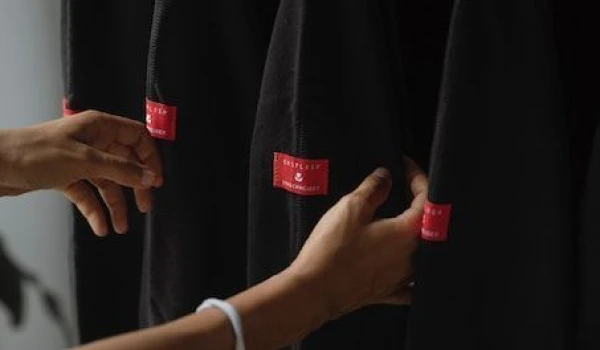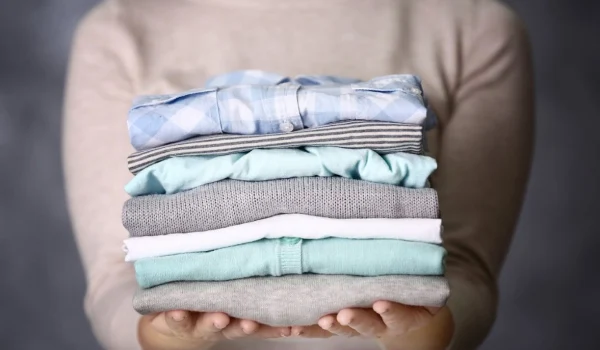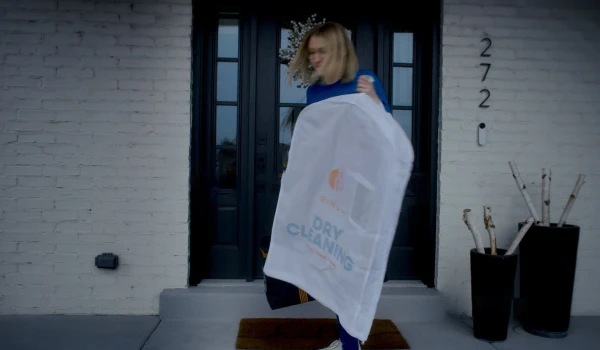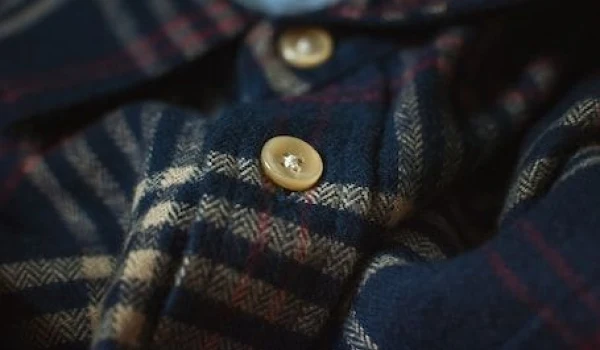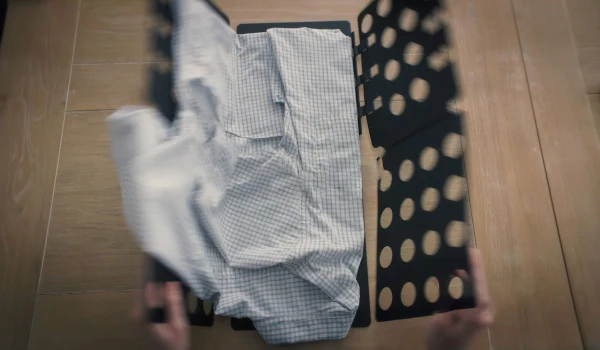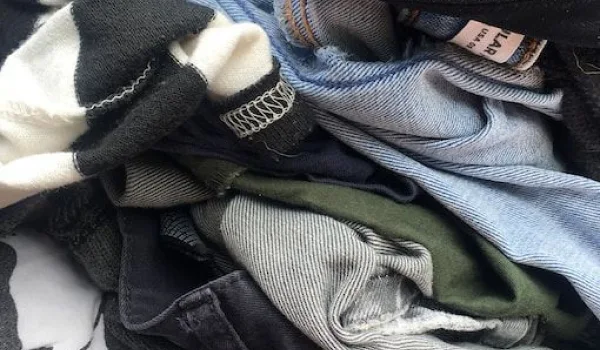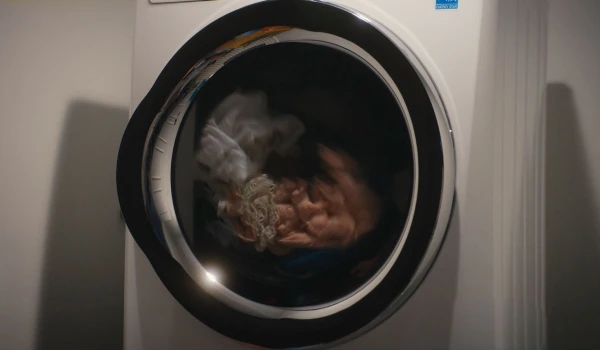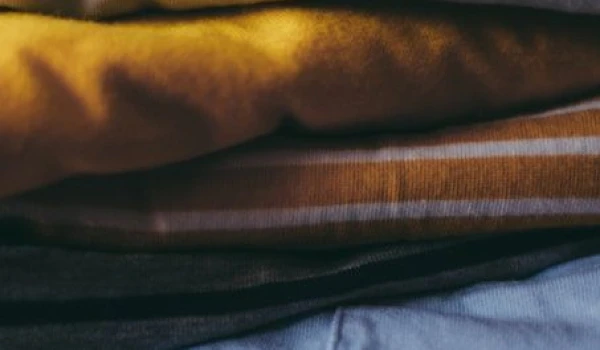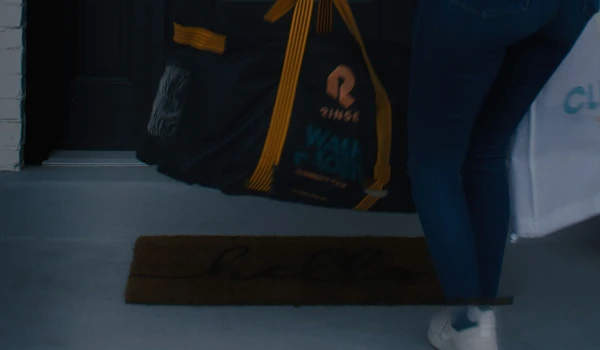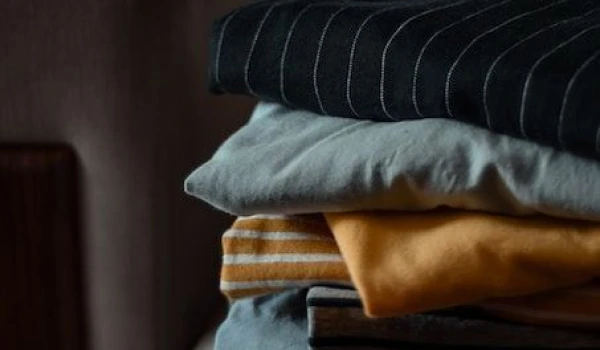Care
Clothing care tips to make your wardrobe last

Introduction
White laundry often loses its brightness over time, leaving clothes looking dull, stained, or even gray. Whether it’s your favorite white shirt or a set of bed sheets, keeping whites bright can be a frustrating task. Even when you reach for traditional chlorine bleach, it may not always give you the desired results and can damage fabrics over time. Fortunately, there are several non-toxic bleach alternatives that can help restore your white clothes and maintain their vibrancy without harmful chemicals. This article will delve into why white laundry loses its brightness and explore eco-friendly alternatives to keep your whites looking their best.
Why Does White Laundry Become Dull?
Before diving into bleach alternatives, it's essential to understand why white laundry dulls over time. Here are the most common reasons:
Repeated Use of Traditional Bleach
Ironically, chlorine bleach, while effective at whitening clothes initially, can actually contribute to fabric discoloration in the long run. Regular use of bleach weakens the fabric fibers and causes them to yellow or gray. The harsh chemicals in chlorine bleach also degrade the material over time, making your white clothes look worn out.
Exposure to Hard Water
Hard water contains high levels of minerals like calcium and magnesium, which can cause white laundry to lose its brightness. These minerals build up in fabric fibers, creating a grayish hue and reducing the fabric's ability to stay clean. If you live in an area with hard water, your white clothes may look dingy even after washing.
Detergent and Fabric Softener Residue
Using too much laundry detergent or fabric softener can leave behind residues on your clothes. Over time, these residues build up in the fibers, making white clothes appear dull and less vibrant. This residue can also attract dirt, making it harder to remove stains.
Color Transfer from Other Fabrics
One of the most common culprits behind dull whites is color transfer from darker fabrics. Washing your whites with darker clothes can cause colors to bleed onto your white garments, leaving them with a faded or dingy appearance. It’s essential to sort your laundry properly to avoid this problem.

8 Non-Toxic Laundry Bleach Alternatives
Now that you know why your white clothes may be losing their brightness, let’s explore some non-toxic bleach alternatives that can help you restore your whites naturally. These eco-friendly options are effective stain removers and whiteners that won’t harm your fabric or the environment.
1. Hydrogen Peroxide
Hydrogen peroxide is a natural whitener and disinfectant, making it a great substitute for bleach. It’s effective at removing stains and brightening whites without causing damage to your clothes. Add one cup of hydrogen peroxide to your washing machine's bleach dispenser or directly into the drum before starting the wash. It works best in warm water and can safely be used on most fabrics.
2. Lemon Juice
Lemon juice is another excellent natural whitener. Its acidity helps break down stains, remove odors, and brighten your white clothes. To use lemon juice as a bleach alternative, add half a cup of freshly squeezed lemon juice to your laundry detergent or soak your white clothes in a mixture of lemon juice and hot water for an hour before washing. For an extra whitening boost, let your clothes dry in the sunlight after rinsing out the lemon juice.
3. Baking Soda
Baking soda is a versatile household staple known for its cleaning properties. It works as a bleach alternative by brightening whites, removing stains, and neutralizing odors. Add half a cup of baking soda to your regular **laundry detergent** when washing white clothes to help keep them bright. Baking soda is gentle on fabrics and works well for people with sensitive skin.
For more tips on using baking soda in laundry, check out our detailed guide here.
4. Distilled White Vinegar
Distilled white vinegar is an effective stain remover and fabric softener, and it can also whiten your clothes. Its mild acidity helps dissolve detergent residue and mineral buildup, keeping white laundry fresh and bright. Add one cup of vinegar to the rinse cycle or place it in the fabric softener compartment of your washing machine to help whiten your clothes. You can also pre-soak your whites in a mixture of vinegar and warm water before washing.
5. Oxygen Bleach
Unlike chlorine bleach, oxygen bleach (often sold under brand names like OxiClean) is non-toxic and eco-friendly. It works by releasing oxygen to break down stains and brighten fabrics. To use oxygen bleach, dissolve the recommended amount in water and add it to your laundry. This bleach alternative is effective at removing stains and whitening clothes without the harsh effects of chlorine bleach.
6. Salt
Surprisingly, salt can be used as a natural whitener and stain remover. It helps to break down dirt and grime in fabric, making your whites brighter. Add a quarter cup of salt to your wash cycle along with your regular laundry detergent. It’s a great solution for reviving yellowed or dull white clothes without any harsh chemicals.
7. Sunlight
Harnessing the natural power of sunlight is an easy and chemical-free way to whiten your clothes. Drying your white laundry outside in direct sunlight helps to naturally **whiten** and brighten fabrics. Sunlight acts as a natural bleaching agent and can even help remove stains. Just be cautious with delicate fabrics like silk, as excessive sunlight exposure can weaken fibers over time.
8. Essential Oils
While essential oils like lemon or tea tree oil are primarily known for their pleasant scents, they also have antibacterial properties and can help keep your clothes smelling fresh. Add a few drops of essential oil or laundry detergent to your wash cycle to refresh your white clothes. While essential oils won't necessarily whiten your laundry, they work well alongside other bleach alternatives like vinegar or baking soda.

Keep Your White Clothes White with Rinse
Maintaining the brightness of white clothes can be a challenge, but with the right care, it’s possible to keep them looking fresh without the use of harsh chemicals like chlorine bleach. If you're looking for a convenient and eco-friendly solution to care for your whites, consider using Rinse's professional laundry services. Rinse offers a gentle cleaning process that restores and maintains the brightness of your white clothes while being mindful of the environment and fabric longevity.
Rinse takes the hassle out of laundry and ensures that your white clothes get the specialized treatment they deserve. Whether you're trying to brighten dull whites or simply clean your favorite garments, Rinse has you covered.
For more tips on eco-friendly laundry care, check out our guide on using lemon juice and baking soda for cleaning, or explore our article here on how to tackle tough stains with non-toxic methods.
Contact us at Rinse today to see our skill in action.

Have laundry or dry cleaning to do?
Rinse picks up, cleans and delivers 7 days a week. Amazingly awesome. Ridiculously simple.

Introduction
Choosing the right laundry detergent is more than just picking your favorite scent or a familiar brand. It involves understanding the ingredients that help clean your clothes and knowing which chemicals to avoid for a healthier, more eco-conscious laundry routine. In this article, we’ll uncover common ingredients in detergents, highlight chemicals to steer clear of, and explain how detergents work to effectively clean fabrics. Finally, we'll introduce Rinse's commitment to safe and sustainable laundry care solutions.
Laundry Detergent: 8 Common Ingredients
Understanding what’s inside your laundry detergent is essential for making informed decisions about the products you use. Here are eight common ingredients that play a key role in the cleaning process:
1. Surfactants
Surfactants are the backbone of laundry detergents, responsible for breaking the surface tension of water so it can more easily penetrate fabric fibers. This helps lift dirt, oil, and stains from your clothes. Surfactants like sodium lauryl sulfate (SLS) are commonly found in both liquid and powder detergents.
2. Enzymes
Enzymes are naturally occurring proteins that target specific types of stains. For example, proteases break down protein-based stains like sweat and blood, while amylases work on carbohydrate-based stains like food. Enzyme-containing detergents are especially effective at removing tough stains without needing to rely on bleach.
3. Builders
Builders help to soften hard water by neutralizing the minerals in it, allowing the detergent to work more efficiently. Sodium carbonate (also known as wash soda) is a common builder found in many laundry detergents. Builders also prevent soap scum from forming on clothes, keeping them cleaner.
4. Bleaching Agents
Bleaching agents like hydrogen peroxide or sodium percarbonate are used to whiten and brighten clothes, removing stains such as wine, coffee, and grass. Unlike chlorine bleach, these oxygen-based bleaches are gentler on fabrics and don’t produce toxic fumes.
5. Fragrances
Fragrances are added to laundry detergents to give clothes a fresh scent after washing. While many consumers enjoy the smell of a "clean" product, synthetic fragrances can sometimes cause skin irritation and contribute to indoor air pollution. Opt for fragrance-free or naturally scented detergents when possible.
6. Stabilizers
Stabilizers help maintain the formula’s effectiveness over time, preventing the detergent ingredients from breaking down or separating. They ensure that your liquid or powder detergent works consistently from the first wash to the last.
7. Antiredeposition Agents
These agents prevent dirt and stains from re-depositing on clothes during the wash cycle. They work by keeping dirt particles suspended in the water so they can be rinsed away, ensuring your laundry comes out clean.
8. Chelating Agents
Chelating agents, such as ethylenediaminetetraacetic acid (EDTA), bind to metal ions like calcium and magnesium found in hard water. By doing so, they improve the efficiency of the surfactants and enzymes, especially in areas with hard water. This prevents dullness in white laundry caused by mineral deposits.

What Chemicals Should You Avoid?
Choosing a clean product for your laundry routine is about more than just finding an effective detergent. It's crucial to avoid harmful chemicals that can pose risks to your health and the environment. Here are six chemicals to be cautious of when selecting your laundry detergent:
Phosphates
Phosphates are used as builders in detergents but can cause significant environmental harm. When they enter water systems, phosphates contribute to algae overgrowth, which depletes oxygen levels and threatens aquatic life. Look for phosphate-free detergents to minimize your environmental impact.
Nonylphenol Ethoxylates (NPEs)
NPEs are surfactants that break down into nonylphenol, a toxic substance that can disrupt hormones in both humans and wildlife. Many countries have banned NPEs due to their harmful effects, but they may still be present in some products. Opt for detergents labeled NPE-free.
Optical Brighteners
Optical brighteners are chemicals that coat fabric fibers with a fluorescent layer, making clothes appear whiter and brighter. However, they don’t actually clean clothes, and their residues can cause skin irritation. They’re also not biodegradable, leading to environmental concerns. Instead, look for detergents without optical brighteners.
Synthetic Fragrances
While a fresh scent might seem appealing, synthetic fragrances can contain hundreds of chemicals, some of which are linked to allergies, asthma, and hormone disruption. Choose fragrance-free or naturally scented products that use essential oils for a safer alternative.
Formaldehyde
Formaldehyde is a preservative found in some laundry detergents. It is a known carcinogen and can also cause respiratory issues and skin irritation. Always check ingredient lists and avoid detergents that contain formaldehyde or its derivatives.
1,4-Dioxane
1,4-Dioxane is a byproduct of the manufacturing process for some detergents. It’s classified as a probable human carcinogen, and although it’s not always listed as an ingredient, it can be present in detergents that contain ethoxylated compounds. Look for "1,4-Dioxane-free" labels when shopping for detergent.

How Do Detergents Work While Cleaning Clothes?
Laundry detergents remove stains and grime through a series of chemical processes. Here’s a breakdown of how detergents work to get your clothes clean:
1. Wetting and Penetration
Surfactants in the detergent reduce the surface tension of water, allowing it to penetrate the fabric fibers more easily. This enables the detergent to reach deep into the fabric where dirt and stains reside.
2. Emulsification and Suspension
Once the water and detergent penetrate the fabric, the surfactants emulsify the oils and fats from the stains, breaking them down into smaller particles. These particles are then suspended in the water, preventing them from settling back onto the fabric.
3. Chemical Reaction with Stains
The enzymes and bleaching agents in detergents react chemically with different types of stains to break them down. For example, proteases break down protein-based stains like blood, while oxygen bleach removes organic stains like wine and coffee.
4. Dispersal of Particles
After the stains have been broken down, the detergent ensures that the dirt and particles remain dispersed in the wash water. Antiredeposition agents prevent these particles from settling back onto your clothes during the wash cycle.
5. Rinse and Removal
Finally, the detergent and water work together to rinse away the dirt, oil, and particles that have been lifted from the fabric. This leaves your clothes clean, bright, and fresh, free from the residue of dirt and detergent.

Ensure Safe Detergents With Rinse
At Rinse, we prioritize the use of safe, eco-friendly detergents in all of our laundry services. We understand the importance of maintaining garment quality while also promoting environmentally conscious practices. Our detergent selection process ensures that your clothes are cleaned with products free from harmful chemicals like phosphates, NPEs, and formaldehyde.
By choosing Rinse, you can trust that your laundry is treated with care, keeping your fabrics fresh, clean, and safe for you and the environment. Experience the convenience of professional laundry care while making eco-friendly choices by subscribing to Rinse today.
For more information on laundry detergent, check out our other posts here:
By choosing the right laundry detergent, avoiding harmful chemicals, and understanding how detergents work, you can achieve clean, fresh laundry without compromising your health or the environment.
Contact us at Rinse today to see our skill in action.

Have laundry or dry cleaning to do?
Rinse picks up, cleans and delivers 7 days a week. Amazingly awesome. Ridiculously simple.

Introduction
Black clothes are synonymous with elegance and timeless style, but their allure can quickly diminish if not properly cared for. Nothing is more disappointing than seeing your favorite black garments fade into a dull gray after just a few washes. Proper care is essential to maintain the richness of your dark clothes, ensuring they remain bold and vibrant for years to come. In this comprehensive guide, we'll delve into the secrets of preserving your black wardrobe, from pre-wash rituals to the ideal laundering process and foolproof drying techniques. Whether you're dealing with delicate fabrics or sturdy materials, these expert tips will elevate your garment care routine to a whole new level.
What to Do Before You Wash Black Clothes
Before tossing your black clothes into the washer, taking a few pre-wash steps can make a significant difference in maintaining their deep, luxurious hue. Here's a checklist of essential pre-wash practices to follow:
Sorting Clothes
One of the golden rules of laundry is to always sort your clothes by color. When it comes to dark clothes, this rule is especially crucial. Mixing black garments with lighter ones can lead to color bleeding, which can fade your dark clothes and transfer dye onto your lighter garments. Always separate your black clothes from other colors to preserve their intensity. Consider creating a separate load for dark colors like navy blue and deep green to further prevent any potential dye transfer.
Checking for Stains
Stains can be particularly troublesome on black clothes because they may not always be visible at first glance. Before washing, take the time to inspect each item for any stains or spots. Treat any stains with a stain remover specifically designed for dark fabrics to avoid leaving bleach marks or discoloration. Spot-treating stains before washing ensures that they don't set into the fabric, which can make them much harder to remove later on.
Turning Items Inside Out to Preserve Color Vibrancy
One of the simplest yet most effective ways to protect your black clothes from fading is to turn them inside out before washing. The friction between garments during the wash cycle can cause fabric fibers to break down, leading to a faded appearance. By turning your clothes inside out, you minimize direct contact with other items in the wash, preserving the surface color and preventing pilling.
Reading Labels
Care labels aren't just there for show—they contain vital information on how to properly care for your clothes. Always read the labels on your black garments to determine the best washing method. Some fabrics may require hand washing or dry cleaning to maintain their color and texture. Understanding the symbols on care labels will guide you in choosing the right water temperature, detergent, and drying method for each item. For more detailed guidance, check out our guide to laundry symbol instructions.

How to Wash Black Clothes
Once your black clothes are sorted, inspected, and prepped, it's time to focus on the washing process. Here are some key tips to follow during the wash cycle:
Using Cold Water
Hot water can be harsh on dark clothes, causing the fibers to open up and release dye. This not only leads to fading but can also cause shrinkage in some fabrics. To prevent this, always wash your black clothes in cold water. Cold water is gentle on fabric fibers, helping to preserve the dye and extend the life of your garments. Additionally, washing in cold water is more energy-efficient, making it a win-win for both your wardrobe and the environment.
Choosing the Suitable Detergent
Not all detergents are created equal, especially when it comes to washing dark clothes. Regular laundry detergents may contain bleach or optical brighteners that can strip away color from black garments. Instead, opt for a liquid laundry detergent specifically formulated for dark colors. These detergents are designed to maintain color vibrancy and prevent fading, helping your black clothes stay rich and bold. When choosing a detergent, look for products that are labeled as "color safe" or "for dark colors" to ensure the best results.
Using the Right Amount of Detergent
More detergent doesn't always mean cleaner clothes. In fact, using too much detergent can leave residue on your clothes, which can dull their appearance over time. Follow the detergent manufacturer's guidelines and measure the detergent carefully. For best results, use the smallest amount necessary to get your clothes clean. Overloading the washer can also prevent clothes from being rinsed thoroughly, so be mindful of the load size.
Load the Washer Correctly
How you load your washer can impact the effectiveness of the wash cycle. Avoid overloading the machine, as this can cause clothes to rub against each other more aggressively, leading to color loss and fabric damage. Ensure that your black clothes have enough space to move freely in the washer, allowing the detergent and water to circulate properly. If you're washing delicates, consider placing them in a mesh laundry bag to protect them from snagging or stretching.

How to Dry Black Clothes
Drying black clothes correctly is just as important as washing them properly. The drying process can make or break the longevity of your garments, so follow these best practices to keep your blacks looking their best:
Air-Drying
Air-drying is the gentlest way to dry black clothes and is highly recommended for preserving color vibrancy. Hanging your clothes to dry reduces the risk of shrinkage, fabric weakening, and fading caused by high heat. When air-drying, avoid placing your clothes in direct sunlight, as UV rays can cause colors to fade. Instead, opt for drying racks indoors or in a shaded outdoor area to keep your dark clothes safe from the sun's harsh rays.
Low-Heat Settings
If you must use a dryer, select a low-heat or delicate setting to minimize heat exposure. High heat can break down the fibers in your clothes, causing them to lose their shape and color. Additionally, over-drying can lead to static cling and make your clothes feel stiff. By using a low-heat setting, you can gently dry your clothes without compromising their quality.
Avoiding Direct Sunlight Exposure
While sunlight is great for drying clothes quickly, it's not ideal for black garments. Prolonged exposure to sunlight can cause black clothes to fade and lose their richness. If air-drying outdoors, make sure to hang your clothes in a shaded area to protect them from direct sunlight. Alternatively, dry your clothes indoors near a well-ventilated window to speed up the drying process without the risk of fading.

Elevate Your Black Wardrobe with Rinse
Taking care of your black clothes doesn't have to be a daunting task, but it does require attention to detail and the right techniques. By following the steps outlined in this guide, you can keep your black wardrobe looking fresh, vibrant, and stylish for years to come. However, if you prefer to leave garment care to the experts, consider using Rinse's professional laundry services. Our team is skilled in preserving the color and quality of your clothes, ensuring they receive the best care possible. With our convenient door-to-door service, you can enjoy perfectly cleaned and maintained clothes without lifting a finger.
For more laundry tips and expert advice, explore our blog:
Contact us at Rinse today to see our skill in action.

Have laundry or dry cleaning to do?
Rinse picks up, cleans and delivers 7 days a week. Amazingly awesome. Ridiculously simple.

Introduction
Washing machine mold is a frustrating and often alarming problem for many homeowners. Discovering a moldy odor or black mold inside your machine is not only inconvenient but can also pose potential health risks. If you’ve encountered this issue, you’re not alone, and there are effective solutions to tackle it. In this article, we will explore the causes of mold growth, offer step-by-step instructions on how to remove it, and share preventive measures to keep your washing machine mold-free in the long run.
Why Do I Have Mold in My Washing Machine?
Understanding why mold grows in washing machines is the first step in preventing it. Mold thrives in environments that are dark, damp, and poorly ventilated, making your washing machine the perfect breeding ground for it. Let’s break down the key factors that lead to mold growth.
Residual Moisture and Humidity
One of the primary causes of mold in your washing machine is moisture left behind after each wash. Both front-load washers and top-load machines can trap residual water, especially in the gasket, rubber seal, or detergent drawer. Over time, this trapped water creates an ideal environment for mold and mildew to form.
Leftover Detergent and Fabric Softener
Using too much detergent or fabric softener can also contribute to mold growth. Excess detergent can leave a residue inside the machine, which not only reduces washing efficiency but also provides a food source for mold. Fabric softener, especially in high concentrations, can form a sticky film that traps moisture, further encouraging the growth of mold.
Inadequate Ventilation
Many washing machines, especially front-load washers, are kept closed between uses, which traps humidity inside. Without proper ventilation, moisture lingers, making it easier for mold to take hold. Leaving the washer door closed prevents airflow, a critical component in keeping the machine dry and mold-free.

How to Remove Mold From My Washing Machine
If you’ve already discovered mold in your washing machine, don’t panic. Here’s a step-by-step guide to effectively clean and remove mold, especially black mold, from your washer and keep it in optimal condition.
Step 1: Clean the Gasket and Rubber Seal
The first place to check for mold is the gasket or rubber seal around the door, particularly in front-load washers. Start by wiping it down with a cloth dampened in warm, soapy water. For more stubborn mold or mildew, use a mixture of white vinegar and water. Scrub the seal thoroughly to remove mold, paying special attention to any crevices where water collects.
Step 2: Run a Hot Water Cycle with Bleach
Once you’ve cleaned the gasket, run a hot water wash cycle using bleach. Set your washer to the hottest setting, add 1 cup of bleach directly into the drum or detergent compartment, and run a full cycle. Bleach is effective at killing mold and mildew and will sanitize the interior of the machine.
Step 3: Clean the Detergent Drawer
Remove the detergent drawer and clean it thoroughly. Often, this is a neglected area where detergent and fabric softener residue can accumulate, leading to mold growth. Soak the drawer in hot, soapy water and scrub away any build-up before rinsing and drying it.
Step 4: Wipe Down the Drum and Door
Once the hot water cycle is complete, wipe down the drum and inside of the door with a clean, dry cloth. This helps remove any residual water and prevents moisture from settling in the machine. Don’t forget to also clean the exterior of the washer, especially around the door hinges.
Step 5: Run a Rinse Cycle with White Vinegar
To ensure all traces of mold and bleach are removed, run another hot water cycle, this time with 1 cup of white vinegar. Vinegar acts as a natural disinfectant and deodorizer, eliminating any lingering mold spores and odors from your washer.

How to Prevent Mold in a Washing Machine
Now that you’ve successfully removed mold from your washing machine, it’s time to focus on prevention. Follow these simple tips to keep mold at bay and maintain a fresh, clean washer.
1. Leave the Door Ajar
One of the easiest and most effective ways to prevent mold growth in your washing machine is to leave the door slightly open between washes. This allows airflow and helps dry out any remaining moisture inside the drum and rubber seal.
2. Clean the Gasket Regularly
The gasket and rubber seal are the most vulnerable parts of a washing machine when it comes to mold. Wipe them down with a dry cloth after each wash, and give them a more thorough cleaning at least once a month using a mixture of water and vinegar.
3. Use the Correct Amount of Detergent
Using too much detergent can leave behind a residue that promotes mold growth. Always follow the manufacturer’s instructions for the correct amount of detergent, and consider using powder detergent or a liquid detergent designed for high-efficiency washers.
4. Run a Monthly Cleaning Cycle
Running a monthly cleaning cycle with hot water, vinegar, or bleach can help prevent mold from taking hold in your washer. Most modern washing machines have a self-cleaning cycle specifically designed for this purpose.
5. Clean the Detergent Drawer
The detergent drawer is a prime location for mold growth due to trapped moisture and leftover detergent. Remove and clean the drawer regularly to prevent mold buildup.
6. Avoid Excess Fabric Softener
Fabric softener is a common culprit in mold growth, as it leaves a sticky residue that traps moisture. Instead, opt for natural alternatives like white vinegar, which softens clothes without contributing to mold problems.
7. Dry the Drum After Every Wash
After each wash, use a dry cloth to wipe down the drum and inside the door. This simple step removes any lingering moisture and prevents it from accumulating in the machine.

FAQs
What is the Best Product to Use to Remove Mold?
To remove mold effectively, a combination of white vinegar and bleach works best. Vinegar is a natural and eco-friendly cleaning solution, while bleach is powerful at killing mold spores. When used together, these products can eliminate mold and prevent future growth. However, never mix bleach and vinegar directly, as this can produce harmful fumes.
How Often Do I Have to Clean the Mold Out of My Washing Machine?
Ideally, you should clean your washing machine every month to prevent mold from forming. Regular maintenance, including cleaning the gasket, detergent drawer, and running a cleaning cycle, can keep your washer mold-free.
Is Mold in a Washing Machine Harmful?
Yes, mold in a washing machine can be harmful to your health. Mold spores can cause respiratory issues, allergic reactions, and skin irritation. Additionally, moldy washing machines may transfer spores to your clothing, affecting your laundry’s freshness.
Can Mold in a Washing Machine Affect My Clothes?
Moldy washing machines can make your clothes smell musty and leave dark spots on fabrics. In severe cases, mold can even cause discoloration or damage to clothing. Regular cleaning and mold prevention steps are essential to keep your clothes fresh and clean.

Rinse Away Mold Stress: Elevate Your Laundry Game Today!
Mold maintenance can be tedious, but with Rinse’s expert laundry and cleaning services, you don’t have to worry about it. At Rinse, we ensure that your garments are cleaned in mold-free, safe conditions, giving you peace of mind and fresher laundry every time. And by outsourcing your laundry to us, you don't have to ever worry about mold creepign into your machine or making any preventative steps. Let us make doing laundry cleaner and more convenient so you have more time to spend on the important things in your life.
For more tips on washing machine care, check out these related articles:
Contact us at Rinse today to see our skill in action.

Have laundry or dry cleaning to do?
Rinse picks up, cleans and delivers 7 days a week. Amazingly awesome. Ridiculously simple.

Introduction
Doing laundry isn’t a one-size-fits-all task, and not all garments can withstand the rigor of a standard wash cycle. Many of us have faced the frustration of pulling out wrinkled or damaged clothes, wondering where things went wrong. That’s where specialized settings like the permanent press cycle come into play. This cycle is designed to gently clean and dry certain types of fabrics, ensuring they come out wrinkle-free and looking their best.
In this guide, we’ll dive deep into the permanent press cycle for both washing machines and dryers, highlighting its features, benefits, and when you should or shouldn’t use it.

What is the Permanent Press Cycle on Washers?
The permanent press cycle on washing machines is designed to minimize wrinkles and preserve the integrity of fabrics prone to creasing. Unlike the normal or delicate wash cycles, the permanent press setting uses a combination of warm water and slow spin cycles. Warm water helps to relax the fabric fibers, and the reduced agitation during the spin cycle prevents wrinkles from forming.
This cycle is particularly useful for synthetic fabrics like polyester and blends, which tend to wrinkle easily. It’s also ideal for garments that require a little extra care but don’t need the gentle touch of a delicate wash. In most front load washers, the permanent press cycle runs at a slower pace and uses less agitation than regular cycles, making it suitable for items that require moderate cleaning but still need wrinkle protection. For more information, check out our article on different washing machine cycles.
What is the Permanent Press Cycle on Dryers?
While the washer version of the permanent press cycle focuses on reducing wrinkles through controlled agitation, the dryer setting takes it a step further. The permanent press cycle on dryers uses medium heat to dry clothes. This lower heat level is essential for protecting synthetic fibers from the damage caused by high temperatures while still being hot enough to dry the clothes without excessive creasing.
The dryer cycle typically ends with a cool-down phase, where room-temperature air is used to further prevent wrinkling. This feature ensures that clothes emerge from the dryer looking neat, wrinkle-free, and ready to wear.
If you’ve ever wondered why some fabrics feel stiff or wrinkled after drying, it’s likely because they were exposed to high heat without the gentle care that the permanent press cycle offers. By using this setting, you can preserve your garments for longer, keeping them looking fresh and reducing the need for ironing.

Benefits of Using the Permanent Press Cycle
When it comes to protecting your clothes and ensuring they stay wrinkle-free, the permanent press cycle offers several advantages. Here are some key benefits:
-
Reduced wrinkles: This cycle is designed to prevent creasing, ensuring your clothes come out smooth and ready to wear.
-
Energy efficiency: The reduced agitation and medium heat settings make this cycle energy-efficient, as it uses less water and power compared to the normal cycle.
-
Enhanced fabric preservation: By using lower heat and gentle spin cycles, the permanent press cycle protects fabrics from excessive wear and tear.
-
Time-saving: With fewer wrinkles, you’ll spend less time ironing, allowing you to wear your clothes straight out of the dryer.
-
Versatility: This cycle is perfect for a wide range of synthetic fabrics and blends, making it a go-to for everyday wear.
If you’re trying to balance fabric care with energy efficiency, the permanent press cycle is a great choice.

What Clothes Should I Put in a Permanent Press Cycle?
The permanent press cycle is perfect for a wide range of clothing items and fabrics that require gentle care. These include:
-
Synthetic fabrics such as polyester, nylon, and acrylic
-
Blended fabrics like cotton-polyester blends
-
Dress shirts and blouses made from wrinkle-prone materials
-
Trousers and slacks that need to maintain a smooth appearance
-
Bed linens and curtains that wrinkle easily
If your garment’s care label specifies “Permanent Press” or “Tumble Dry Medium,” the permanent press cycle is the best option to maintain its quality.
However, not all fabrics are suited to this cycle. For instance, items like delicates, wool, or silk are better off being washed in the delicate wash cycle to avoid damage. Still others are best off being sent for Dry Cleaning - read our article here on the benefits of dry cleaning and which clothes can be dry cleaned.
When Should I Use or Not Use the Permanent Press Cycle?
While the permanent press cycle is highly versatile, there are instances where it shines and others where it might not be the best option. Let’s break it down:
When to Use the Permanent Press Cycle:
-
When washing synthetic fabrics like polyester, acrylic, and nylon
-
For blended garments that need to maintain a smooth appearance
-
When drying clothes that are prone to wrinkling, such as dress shirts, slacks, or bed linens
-
When trying to save energy by using medium heat instead of high heat in the dryer
-
For workwear that needs to look polished but doesn’t require the gentleness of a delicate wash
When Not to Use the Permanent Press Cycle:
-
For delicate fabrics such as wool, silk, or cashmere, which require lower temperatures and gentler care
-
When washing items that need heavy-duty cleaning, such as towels or heavily soiled work clothes
-
For sturdy fabrics like denim or canvas that don’t wrinkle easily and can withstand high heat and more vigorous agitation
Being mindful of when to use the permanent press cycle will extend the life of your clothes and help them look their best.

FAQs
What’s the difference between the permanent press and delicate cycle?
The delicate cycle is designed for very fragile fabrics like silk or lace, using cold water and minimal agitation. In contrast, the permanent press cycle uses warm water and a slower spin cycle to protect clothes while preventing wrinkles, making it ideal for synthetic blends.
What’s the difference between the permanent press and normal cycle?
The normal cycle uses high heat, fast agitation, and fast spin cycles, which can be harsh on fabrics that are prone to wrinkling. The permanent press cycle uses gentler agitation and medium heat, which is better suited for clothes that need wrinkle prevention.
Is the permanent press cycle for delicates?
No, the permanent press cycle is not for delicates. Delicate fabrics require more gentle care, so it’s better to use a delicate wash or hand wash for items like silk, lace, or cashmere.

Rinse: Where Convenience Meets Quality
At Rinse, we understand the importance of proper fabric care. That’s why we prioritize gentle and effective cleaning techniques, ensuring your garments are handled with care every step of the way. Send your clothes to us for Wash & Fold for crisply folded or Dry Clean for sharply pressed clothes, delivered directly to your door. Whether you're looking to outsource all your laundry or just a few garments that require extra care, Rinse is committed to helping you maintain your wardrobe with convenience and quality. Let us handle the intricacies of laundry so you can enjoy clean, wrinkle-free clothes without the hassle.
For more helpful posts, read our articles on:
Contact us at Rinse today to see our skill in action.

Have laundry or dry cleaning to do?
Rinse picks up, cleans and delivers 7 days a week. Amazingly awesome. Ridiculously simple.

Introduction
Stains can be a nightmare, especially when they seem impossible to remove. But before you toss your stained garment in the wash, have you considered pretreating it? Pretreating stains is a critical step in the laundry process, helping to break down tough spots and giving your laundry detergent the upper hand. In this comprehensive guide, we’ll dive into why pretreating stains is essential, explore the best methods for doing so, and share some key tips to make your laundry routine easier and more effective.
Why is Pretreating Stains Important?
Pretreating stains is more than just an optional step—it’s a necessity. When you directly address a stain before washing, you give your detergent the opportunity to perform at its best. Here’s why pretreating stains is so important:
-
Breaks Down Stains Early: When you apply a stain remover or other pretreatment method before washing, it immediately begins breaking down the stain at its source, preventing it from setting deeper into the fabric.
-
Boosts Detergent Effectiveness: Pretreatment helps soften and dissolve the stain, allowing your laundry detergent—whether it’s liquid laundry detergent or powder laundry detergent—to clean the fabric more effectively. Without this step, your detergent might struggle to fully remove stubborn spots.
-
Prevents Stain Setting: Washing a stained garment without pretreatment can sometimes cause the stain to set further into the fibers, especially if you use hot water. Pretreating the stain ensures that the detergent can lift and remove the mark before it becomes permanent.
-
Saves Your Garments: Regularly pretreating stains can significantly extend the lifespan of your clothes. Without deep-set stains, your favorite pieces will continue to look fresh and new.

4 Pretreat Stain Removal Methods
Now that you know why pretreating stains is crucial, let’s explore some of the best and most effective methods for pretreating various stains.
Laundry Detergent
One of the simplest and most accessible ways to pretreat a stain is by using your regular laundry detergent. Apply a small amount of liquid laundry detergent directly to the stain and gently rub it in using your fingers or a soft-bristled brush. Let it sit for at least 10 minutes before washing. This method works well for most common stains, like grease stains or food marks.
Looking for an eco-friendly solution? Consider using natural or homemade laundry detergent to keep your stain-fighting routine clean and green!
Vinegar and Baking Soda
This classic duo is a powerful and natural stain remover. For stubborn stains, mix equal parts vinegar and baking soda to form a paste. Apply this paste to the stain and let it sit for 15-30 minutes before laundering. This method works particularly well on red wine stains, grease stains, and other stubborn spots. The acidic nature of vinegar breaks down organic material, while baking soda acts as a mild abrasive.
For more tips on using baking soda and vinegar in laundry, check out our guide here.
Commercial Laundry Stain Remover Sprays
There are plenty of commercial laundry stain remover sprays on the market that can help you tackle specific stains. These sprays are designed to break down the molecular structure of stains and make them easier to wash away. Look for products that are targeted toward specific types of stains, such as grease stains, ink stains, or wine stains. Enzymatic stain removers are better for organic stains, like grass, food, and other types of biologic matter. Spray the affected area and let it sit for 5-10 minutes before washing. Make sure to follow the manufacturer’s instructions for the best results.
DIY Pre-Treater
For those who love DIY, making your own pre-treater is a fun and effective solution. Mix 1 part water with 1 part liquid laundry detergent and 1 part hydrogen peroxide. Store this solution in a spray bottle and apply it to stains as needed. Let it sit for about 15 minutes before washing. This solution works wonders on tough stains like sweat marks or food spills.

3 Tips to Keep in Mind
While pretreating stains can significantly boost your stain removal efforts, there are a few things to keep in mind to make sure you don’t unintentionally damage your garments.
Avoid Rubbing Fabric Together
When pretreating a stain, avoid the temptation to rub the fabric together vigorously. This can cause the stain to spread or even damage the fabric fibers. Instead, gently dab or blot the stain with a cloth or your fingers. For delicate fabrics like silk or wool, be extra cautious and use a soft cloth for blotting.
Apply the Method to Both Sides of the Garment
For particularly stubborn stains like a red wine stain or grease mark, be sure to apply your stain remover to both sides of the fabric. This ensures that the solution can thoroughly penetrate the fibers and break down the stain from both directions.
Pretreat as Early as Possible
The sooner you pretreat a stain, the higher the chance of complete removal. Fresh stains are much easier to remove than stains that have had time to set in. If you can’t wash the item immediately, at least apply the pretreatment as soon as possible and let it sit until you’re ready to launder the garment.
For more detailed advice on removing tough stains, check out our guide on how to get old stains out of clothes.

Achieve Stain-Free Perfection: Discover Rinse!
Let’s face it—sometimes, no matter how hard we try, stains are just too stubborn to remove on our own. But you don’t have to tackle tough stains alone! At Rinse, we take the hassle out of stain removal with our professional dry-cleaning services.
With Rinse, you can trust our experienced team to remove stains like grease stains, red wine stains, and more using the best pretreatment methods. We use top-quality stain removers and advanced techniques to ensure your clothes are returned to you looking spotless and fresh. Ready to give your clothes the care they deserve? Send your stained garments for Dry Cleaning service, and we'll professionally spot-treat your stains. For more information on how our dry cleaning service can help remove stains, check out our blog post here.
Not only do we save you time, but our expertise ensures that even the most delicate fabrics are treated with care. Whether you have a silk blouse, a wool sweater, or everyday wear, Rinse's Dry Cleaning service provides the professional care your garments need to last longer and look their best. Looking to save yourself the hassle of regular laundry? Send your clothes in for wash and fold and we'll make sure your clothes are cared for from door to door.
For more laundry tips and expert advice, check out our guides on how to remove chocolate stains or hot or cold water for stains. Happy laundering!
Contact us at Rinse today to see our skill in action.

Contact us at Rinse today to see our skill in action.
Topics
Rinse Drop
We offer pickup and delivery if you can’t be present between 8pm and 10pm.
Our Valet will pick up or deliver your order to your doorstep or concierge, at which point you’ll receive a text with a photo showing where your items were left.
You can enable Rinse Drop on any (or all) of your orders.

